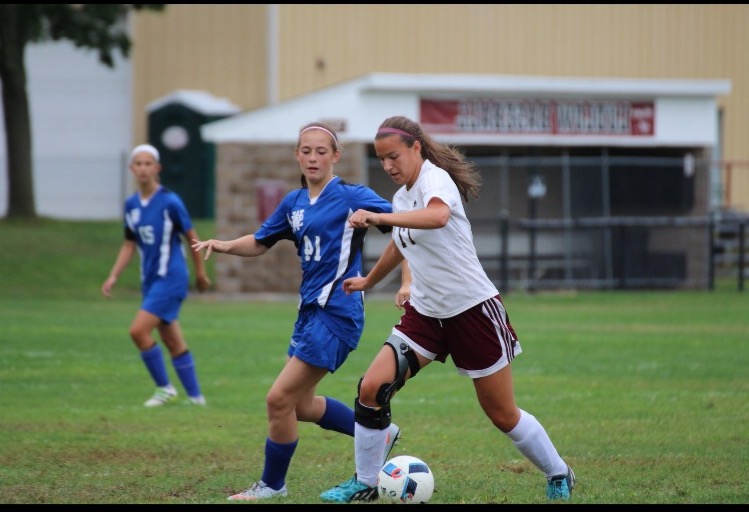475 Days
One athlete’s struggle to return back to the sport she loves. Part I of the Cub series on student-athlete injuries.
Silva, in her 2016 season, dribbling up the field against Westside
October 13, 2016
I’ve been waiting for today for 475 days, Alexandra Silva thought to herself as her orthopedist told her she was cleared to play soccer.
It was July 14, 2016 and Alexandra, known as Alex to friends and family, had finally won the battle against her troublesome ACL and meniscus tears that had loomed over her for almost a year and a half.
In March of her freshman year, Silva was playing in a pre-season NEFC tournament with her premier soccer team to warm up for their upcoming spring season. The fields were slick with melting snow and more continued to rain down upon players and spectators alike.
Silva had been chasing an offensive run made by the other team when her goalie, Gillian Duquette, sprinted out of goal to prevent a shot on net. In an attempt to not collide into her teammate, Silva jumped over Duquette who had dove on top of the ball.
“When I was mid air, I felt a pop in my left leg,” Silva said. She then fell on the ground and was unable to get up. “My leg was stuck at a 90-degree angle and I couldn’t walk on it. The weird thing was, it didn’t hurt.”
Silva spent that night in the emergency room of a local hospital where she underwent a series of tests as well as her first set of x-rays.
She would be subjected to more testing and an MRI scan in the following weeks before her orthopedist was able to determine that Silva had torn the anterior cruciate ligament, more commonly referred to as the ACL, and meniscus in her left leg.
Silva admitted that when she discovered the extent of her injury, she “was devastated and cried a lot. I knew I wouldn’t be able to play soccer for the next few months.”
Statistics show that Silva’s injury is becoming more prevalent in female athletes enrolled in high intensity sports such as soccer. Recent research studies indicate that females are 4-8 times more likely to damage their ACLs than their male counterparts.
Title IX, a federal law passed in 1972, mandated that high schools had to offer female athletics. This law caused a jump in female athletic competition and injuries such as the ACL and meniscus tears to become a forefront issue threatening female athletes.
Biology is partly to blame for the increased risk of female athletes injuring their ACLs. Although there’s a plethora of ways to tear one’s ACL, science shows that the female pelvis is wider and larger which is necessary for childbirth. This skeletal difference causes a female’s thigh bones to be more sharply angled than a male’s, which puts more pressure on a girl’s knee, ultimately resulting in ACL tears. The average rehabilitation time for an ACL surgery ranges anywhere from six to nine months.
Although there seems to be an increasing risk of a severe ACL tear, the reality is, athletes are virtually unaware of the injury that can be a threat to their careers.
“I didn’t know it was such a common injury,” Silva confessed. “I had never seen anyone else with this injury before it happened to me.”
Days after receiving the diagnosis, Silva went into surgery to repair the ACL and meniscus tears. The surgery was determined a success and Silva began her aggressive physical therapy treatment soon afterwards.
“Physical therapy was three times a week for almost a year and a half. It was extremely slow, frustrating, and stressful because it wasn’t progressing as fast as it was supposed it,” she said.
Silva found herself stuck on crutches and the sideline while her premier team continued on through their spring season. Instead of attending weekday practices, Silva found herself at home, focusing on her school work and recovery. On the weekends, Silva would support her team from the bench.
“I felt almost like the team’s third coach. I would support the team the best I could. It was heartbreaking to watch people play the sport I love while I was restricted with crutches and a full-leg brace,” Silva admits.
Silva remained her team’s “third coach” for the rest of the spring season while continuing to focus on her rehabilitation.
Unfortunately, Silva’s physical therapy recovery was at a stand still. This lack in progress would lead to Silva needing two more surgeries, one in June of 2015 and the other in April 2016.
Her original surgery left scar tissue in her leg which was supposed to be broken down during her physical therapy sessions.
“The tissue hadn’t separated like it was supposed to and it was preventing my leg from bending properly. The additional surgeries helped to loosen up the scar tissue when physical therapy wasn’t working as well as my doctors had hoped it would,” Silva had to say on the matter.
Still battling her troublesome ACL and meniscus rehab, Silva had no choice but to remain on the bench for her premier team’s 2016 spring season.
“It was hard enough to miss a season with my team, but a second season was just salt in the wound,” said Silva.
Uncertainty clouded the air in July of 2016. Silva had a meeting with her orthopedist that would determine if she had all the qualifications to be cleared and begin training for her upcoming high school fall soccer tryouts.
Going into the meeting, Silva was nervous, this was the make it or break it moment. However, after the appointment, Silva had an extra spring in her step and a megawatt smile on her face.
“When I was finally cleared to come back to soccer, I was relieved and ecstatic. It was like all of my hard work in physical therapy was worth it,” Silva reveals.
Silva spent the rest of her summer on the field and track, training to join her teammates on the field after almost a year and a half of being out.
Silva admits that “it was hard to get back into the swing of things after being out for so long.”
Preparing for the upcoming season wasn’t the only adjustment Silva had to get used to. She’d be returning to the field with an extra piece of equipment, a knee brace.
“It was strange at first but I knew it was going to help prevent another tear,” says Silva.
These braces are controversial in the medical field, as there’s currently not enough data to determine if they hurt or help returning players. Some doctors claim the brace acts in place of certain leg muscles and ligaments leaving the leg more exposed to possible harm, while others say it helps players feel more comfortable when returning to their respective sports.
“I trust my doctor, I wouldn’t be back on the field without him,” Silva said on the matter.
As the school year started up, so did soccer season. Silva started her junior year and her first season back.
“It’s great to be back, I get to get back in shape and feel like a part of the team again. I feel like I’m finally myself again,” Silva admits.
Joe Anselmo, Silva’s coach this fall, had only positive things to say about the returning the player, “I’m very glad to have [Silva] back. She’s a superb and passionate player.”
Silva’s team currently stands undefeated with a record of 10-0. Silva leads the team as one of the captains and is glad to be back home on the field.
When asked if it was worth the 475 day wait, Alex could only reply, “I wouldn’t change it for the world because now I’m back and able to do what I love most on the soccer field.”


